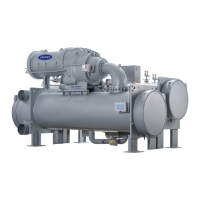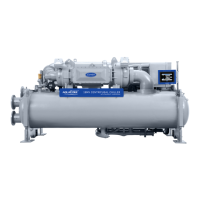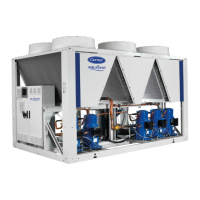21
Tighten All Gasketed Joints
Gaskets normally relax by the time the chiller arrives at the
jobsite. Tighten all gasketed joints to ensure a leak-tight chiller
(does not apply to refrigerant joints covered by factory insula-
tion). Gasketed joints (excluding O-rings) may include joints at
some or all of the following:
• waterbox covers
• compressor suction elbow flanges (at compressor and at
the cooler)
• compressor discharge flange
• compressor discharge line spacer (both sides) if no isola-
tion valve
• cooler inlet line spacer (both sides) if no isolation valve
• hot gas bypass valve (both sides of valve)
• hot gas bypass flange at compressor
See Tables 3 and 4 for bolt torque requirements.
Check Chiller Tightness
Figure 19 outlines the proper sequence and procedures for leak
testing.
The 19XR chillers are shipped with the refrigerant contained in
the condenser shell and the oil charge in the compressor. The
cooler is shipped with a small positive pressure refrigerant
holding charge. Units may be ordered with the refrigerant
shipped separately, along with a 15 psig (103 kPa) nitrogen-
holding charge in each vessel.
To determine if there are any leaks, the chiller should be
charged with refrigerant. Use an electronic leak detector to
check all flanges and solder joints after the chiller is pressur-
ized. If any leaks are detected, follow the leak test procedure
(page 23).
If the chiller is spring isolated, keep all springs blocked in both
directions to prevent possible piping stress and damage during
the transfer of refrigerant from vessel to vessel during the leak
test process, or any time refrigerant is being transferred. Adjust
the springs when the refrigerant is in operating condition and
the water circuits are full.
Table 3 — Bolt Torque Requirements, Foot Pounds
BOLT SIZE
(in.)
SAE 2, A307 GR A
HEX HEAD
NO MARKS
LOW CARBON STEEL
SAE 5
SOCKET HEAD OR HEX
WITH 3 RADIAL LINES, OR SA499
MEDIUM CARBON STEEL
SAE 8
HEX HEAD
WITH 6 RADIAL LINES OR
SA354 GR BD
MEDIUM CARBON STEEL
MINIMUM MAXIMUM MINIMUM MAXIMUM MINIMUM MAXIMUM
1
/
4
4 6 6 9 9 13
5
/
16
8 11 13 18 20 28
3
/
8
13 19 22 31 32 46
7
/
16
21 30 35 50 53 75
1
/
2
32 45 53 75 80 115
9
/
16
46 65 75 110 115 165
5
/
8
65 95 105 150 160 225
3
/
4
105 150 175 250 260 370
7
/
8
140 200 265 380 415 590
1 210 300 410 580 625 893
1
1
/
8
330 475 545 780 985 1,410
1
1
/
4
460 660 770 1,100 1,380 1,960
1
3
/
8
620 885 1,020 1,460 1,840 2,630
1
1
/
2
740 1060 1,220 1,750 2,200 3,150
1
5
/
8
1010 1450 1,670 2,390 3,020 4,310
1
3
/
4
1320 1890 2,180 3,110 3,930 5,610
1
7
/
8
1630 2340 2,930 4,190 5,280 7,550
2 1900 2720 3,150 4,500 5,670 8,100
2
1
/
4
2180 3120 4,550 6,500 8,200 11,710
2
1
/
2
3070 4380 5,000 7,140 11,350 16,210
2
3
/
4
5120 7320 8,460 12,090 15,710 22,440
3 6620 9460 11,040 15,770 19,900 28,440
Table 4 — Bolt Torque Requirements, Foot Pounds (Metric Bolts)
BOLT SIZE
(METRIC)
CLASS 8.8 CLASS 10.9
MINIMUM MAXIMUM MINIMUM MAXIMUM
M4 1.75 2.5 2.5 3.5
M6 6 9 8 12
M8 14 20 20 30
M10 28 40 40 57
M12 48 70 70 100
M16 118 170 170 240
M20 230 330 330 470
M24 400 570 570 810
M27 580 830 820 1175

